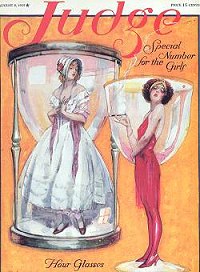 The
Flapper – The "flapper," was the young, independently-minded
woman of the early 1920s. This is an article entitled, "Flapping Not Repented
Of" from the July 16, 1922 New York Times. It discusses the nature
of this new feminine type and tries to project her significance as a historical
phenomena. In all, "flappery" was short-lived. By the end of the twenties,
articles appear in papers addressing the more confident, less gregarious "siren
woman" as over taken the flapper. But during its heyday, the flapper was
a dominate icon representing that woman had shed the parasol and petticoat once
and for all.
The
Flapper – The "flapper," was the young, independently-minded
woman of the early 1920s. This is an article entitled, "Flapping Not Repented
Of" from the July 16, 1922 New York Times. It discusses the nature
of this new feminine type and tries to project her significance as a historical
phenomena. In all, "flappery" was short-lived. By the end of the twenties,
articles appear in papers addressing the more confident, less gregarious "siren
woman" as over taken the flapper. But during its heyday, the flapper was
a dominate icon representing that woman had shed the parasol and petticoat once
and for all.
Petters and Neckers
– In a fairly modern libertine American society it’s difficult
to imagine a social culture where kissing as a form of dating entertainment
was considered rather cutting edge. But indeed, along with the expanding social
freedoms being explored by women in the 20s was a new-found sexuality heretofore
associated with men, or at the least only whispered about behind closed doors.
This is an account of a summer conference of college women written by Eleanor
Rowland Wembridge July 1, 1925. The striking features in the article is how
it explores the new departures being seen in American courtship and as a tangential
issue, the effects of expanding mass education of all classes of people at the
universities.
Humanities
Resource of Mark Hunter
 The
Flapper – The "flapper," was the young, independently-minded
woman of the early 1920s. This is an article entitled, "Flapping Not Repented
Of" from the July 16, 1922 New York Times. It discusses the nature
of this new feminine type and tries to project her significance as a historical
phenomena. In all, "flappery" was short-lived. By the end of the twenties,
articles appear in papers addressing the more confident, less gregarious "siren
woman" as over taken the flapper. But during its heyday, the flapper was
a dominate icon representing that woman had shed the parasol and petticoat once
and for all.
The
Flapper – The "flapper," was the young, independently-minded
woman of the early 1920s. This is an article entitled, "Flapping Not Repented
Of" from the July 16, 1922 New York Times. It discusses the nature
of this new feminine type and tries to project her significance as a historical
phenomena. In all, "flappery" was short-lived. By the end of the twenties,
articles appear in papers addressing the more confident, less gregarious "siren
woman" as over taken the flapper. But during its heyday, the flapper was
a dominate icon representing that woman had shed the parasol and petticoat once
and for all.